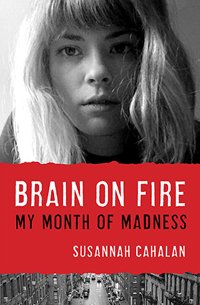The Bell Jar by Sylvia Plath | Book Review
 The Bell Jar by Sylvia Plath
The Bell Jar by Sylvia Plath Genres: American Literature, Fiction, Illness
Original Publication Date: 1963
Source: I purchased this book
Goodreads
Find the Author: Website, Goodreads, Amazon

In The Bell Jar, a vulnerable young woman wins a dream assignment on a big-time New York fashion magazine and finds herself plunged into a nightmare. An autobiographical account of Sylvia Plath’s own mental breakdown and suicide attempt, The Bell Jar is more than a confessional novel, it is a comic but painful statement of what happens to a woman’s aspirations in a society that refuses to take them seriously… a society that expects electroshock to cure the despair of a sensitive, questioning young artist whose search for identity becomes a terrifying descent toward madness.
Contents
The Bell Jar
Esther Greenwood is a brilliant college student who has won a guest editorship at the upscale magazine Ladies’ Day, in June 1953.
Thousands of college students across the United States had entered the contest, and Esther was one of only twelve students who were selected.
The month promises to be exciting and glamorous and may lead eventually to a career in publishing.
But Esther is already aware that something is wrong with her that summer and her immersion into the highly competitive New York publishing world is a shock.
All of her accomplishments, a brilliant academic record, and getting this prized month at a high fashion magazine, mean nothing to her now.
The month is filled with meeting authors, attending dances, fashion shows, and other glamorous activities, but Esther is too miserable to enjoy it.
She is trying to reconcile her love of poetry and literature with the superficial women’s magazines and simply cannot do it.
Electrocutions
Plath opens The Bell Jar with a vivid description of the Rosenbergs in the summer of 1953.
The Cold War is raging, and Ethel and Julius Rosenberg are about to be executed for being spies.
Esther is very upset about the Rosenbergs:
It was a queer, sultry summer, the summer that they electrocuted the Rosenbergs, and I didn’t know what I was doing in New York. I’m stupid about executions. The idea of being electrocuted makes me sick.
It had nothing to do with me, but I couldn’t help wondering what it would be like being burned alive all along your nerves. I thought it must be the worst thing in the world.
Esther feels repressed by the role of women in the 1950s. Here she is, a brilliant young woman, and all of that will be wasted by spending her life serving men.
Her boyfriend Buddy tells her that his mother believes:
What a man is is an arrow into the future and what a woman is is the place the arrow shoots off from.
This really bothers Esther:
That’s one of the reasons I never wanted to get married. The last thing I wanted was infinite security and to be the place an arrow shoots off from. I wanted change and excitement and to shoot off in all directions myself, like the colored arrows from a Fourth of July rocket.
She is tired of the double standard that men can be sexually active and have exciting careers, while a woman is supposed to be a virgin until marriage and then dedicate herself to a life of cleaning and taking care of children.
On her last night in New York, Esther throws away all the clothes she had bought for her New York trip off the top of the hotel.
Suffocating
When she gets home to Massachusetts, she deals with the rejection of not being accepted into a summer writing course at Harvard, a failed attempt at learning shorthand, and her feelings of anxiety and futility.
Not much was understood about clinical depression back in the 1950s, and the stigma of mental illness was very high.
Eventually, her mother realizes that she needs help, and takes her to a doctor.
The highly incompetent doctor prescribes shock treatments for Esther on an outpatient basis and treats her as if she is just a neurotic woman.
They give Esther nothing to lessen the effect of the shock treatment:
Whee-ee-ee-ee-ee, it shrilled, through an air crackling with blue light, and with each flash a great jolt drubbed me till I thought my bones would break and the sap fly out of me like a split plant.
I wondered what terrible thing it was that I had done.
That last line is devastating. The shock treatments make her feel like she’s “being burned alive all along your nerves like the Rosenbergs” and what has she done to deserve this?
It doesn’t relieve her depression, either. It actually makes her even more depressed.
The bell jar has descended.
Esther starts planning different ways to kill herself.
As she says later:
…wherever I sat – on the deck of a ship or at a street cafe in Paris or Bangkok – I would be sitting under the same glass bell jar, stewing in my own sour air.
Finally, she takes most of a bottle of sleeping pills and ends up in the nearest hospital and then is transferred to a posh mental hospital where she is sponsored by the woman who pays her scholarship.
Analysis
The rest of the book deals with Esther’s recovery from her depression and return to normal life.
While the subject matter may be depressing, you really understand how Esther finds herself in her situation.
At first, she is confused. She has no idea what is happening to her. She just knows that something is very wrong.
She also decides that she wants a more fulfilling life – that she also wants to have some of the same chances that men have – academically, sexually, and having an exciting life of career and travel.
She is determined to lose her virginity, and the outcome is quite surprising. But she is determined to be in control.
Esther is not going to let the values of the era defeat her. Her recovery from the depression, whether temporary or not, is a rebirth.
Sylvia Plath was a brilliant writer, and there is a reason that this book is so popular. Young women can truly identify with her.
Further Reading And Viewing
Here is a wonderful, thoughtful review of The Bell Jar by DanWhiteBooks:
Here is a TED-Ed video from Iseult Gillespie: Why should you read Sylvia Plath?
Some of my other reviews:
Chocolates For Breakfast by Pamela Moore | Book Review
Diary of a Mad Housewife by Sue Kaufman
Cassandra at the Wedding by Dorothy Baker.
The Letters of Sylvia Plath, Volume 1: 1940-1956
Sylvia Plath Reading “A Birthday Present”
I Never Promised You A Rose Garden by Joanne Greenberg.
A Tree Grows in Brooklyn by Betty Smith.
Other discussions about this book:
59 Years of Book Covers For The Bell Jar From All Over The World by Lit Hub.
Please check out my posts on New Jersey Memories:
Van Vleck House and Gardens 2023 | Montclair, New Jersey
The Spectacular Rainbow on the Hill: Presby Memorial Iris Gardens 2023 | Montclair, New Jersey
The Caldwell Public Library Building Will Soon Be History | Caldwell, New Jersey
Thank you for reading The Literary Lioness!





